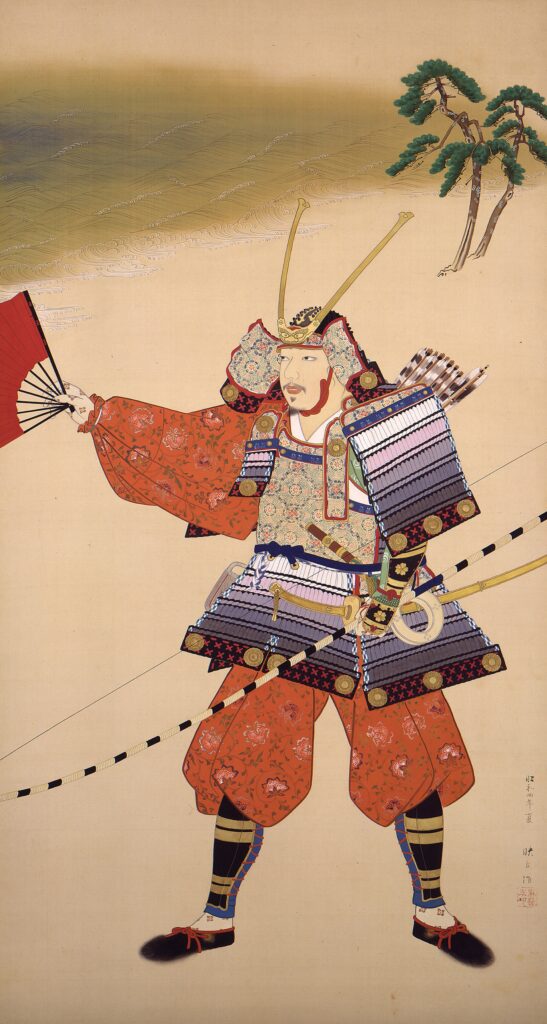

源義経 MINAMOTO no Yoshitsune
1159 – 1189
Name List of Yoshitsune
(Japanese historical figures change their names frequently.)
Ushiwakamaru (牛若丸) → Shanao (遮那王) → Minamoto no Yoshitsune (源義経)
The Genius Military Commander Yoshitsune
Minamoto no Yoshitsune (1159-1189) was a military commander of the Minamoto clan who fought against the Taira clan in the latter years of the Heian period and the early years of the Kamakura period. He appeared in some books such as “Azumakagami”, “The Tale of Heiji”, “The Genpei Seisuiki”, and “The Gikeiki (The Chronicle of Yoshitsune)” where they describe him as a great tactician or a brave militarist. He had two names during his childhood, Ushiwakamaru and Shanao, but today he is commonly recognized as Ushiwakamaru. There are many legendary stories about him such as the moonlight fight with Benkei, a warrior monk (who later he respected and served Yoshitsune as his master), on Gojo Bridge in Kyoto. In recent years, Yoshitsune has been featured by historical novels, game companies, comics, and historical dramas: Shin Heike Monogatari (by Yoshikawa Eiji), Warriors Orochi series (by Tecmo Koei and Omega Force, he appeared in 2 and 3), “Phoenix” (by Tezuka Osamu) and NHK’s taiga drama series: Kamiki Ryunosuke played as Minamoto no Yoshitsune in the drama titled “Taira no Kiyomori” in 2012 featuring actor Kamiki Ryunosuke playing the role of Minamoto no Yoshitsune. Moreover, Kurosawa Akira released the film named “The Men Who Tread on the Tiger’s Tail” in 1945, which featured Kanjincho, the Kabuki which depicts the Minamoto no Yoshitsune and Benkei’s escape through the Ataka barrier.
Early Life
Minamoto no Yoshitsune (named Ushiwakamaru at birth) was born as the 9th son of Minamoto no Yoshitomo and Tokiwagozen. Yoshitomo was the head of the Minamoto clan and fought with Taira no Kiyomori in Hogen Rebellion in 1156. After the Rebellion, the Minamoto clan and the Taira clan started conflicting. Yoshitomo fought against Taira no Kiyomori and lost in the Heiji Rebellion in 1159. After Yoshitomo lost, he escaped to Owari Province (Aichi Prefecture) but, was killed by Osada Tadamune in 1160. Yoshitsune (then named Ushiwakamaru) in his 2nd year, escaped with his mother Tokiwagozen to Yamato Province (Nara Prefecture) in 1160. At the age of 10, Yoshitsune was placed in the care of the monks of the Kurama Temple nestled in the Mt.Hiei near the capital of Kyoto. He changed his name, Ushiwakamaru into Shanao that was derived from Rushana-butsu that is displayed in the Todaiji Temple. In his days of the Kurama Temple, he was said that he was trained by Tengu (“sky dog”), a Japanese legendary creature. At the age of 15, he celebrated Genpuku, a Japanese coming-of-age ceremony in Owari Province where his father died and he relocated to Hiraizumi, Mutsu Province (Iwate Prefecture) to visit Fujiwara no Hidehira. Besides, at that time, he accordingly changed his name into Minamoto no Yoshitsune, whose Yoshi (“義”) was originated from his father’s name and Tsune (“経”) was Minamoto no Tsunemoto, the progenitor of the Seiwa Genji branch of the Minamoto clan.
Career and Footage
In the ensuing war between the Minamoto and Taira clans known as the Genpei War (1180~1185), Yoshitsune and Yoritomo, his older half-brother, united after Yoshitsune defeated Taira no Koremori at the Battle of Fujigawa. At the Battle of Awazu in Omi Province (Shiga Prefecture) in 1184, Yoshitsune defeated his cousin, Kiso no Yoshinaka. Yoshitsune was given a rank of general at the Battle of Ichi no Tani for his miraculous tactic named, “Hiyodori no Sakaodoshi” where he attacked the Taira troops by leading his 70 elite horse soldiers at Ichi no Tani from the mountain ridge to the north. He defeated the Taira troops again at the Battle of Yashima in Shikoku in February 1185, which he sailed through a huge storm to Yashima, the military base of the Taira. The Taira was expecting the naval attack, so Yoshitsune set bonfires on Shikoku to make the Taira troops believe that a large troop was approaching the land. This led Yoshitsune to a huge victory. Besides, in The Tale of Heike, Nasu no Yochi rode out into the sea and fired the famous shot at a fan atop the mast of a Taira ship. One month later, he finally destroyed the Taira clan with his united naval troops at the Battle of Dan no Ura in the present-day Yamaguchi Prefecture. After the Genpei War, Yoshitsune was appointed as the governor of Iyo Province (Ehime Prefecture) by the cloistered Emperor Go-Shirakawa; however, his brother Yoritomo opposed to Yoshitsune’s titles and Yoshitsune’s assistant, Kajiwara Kagetoki told Yoritomo that Yoshitsune appropriated the reward. His opinion incurred Yoritomo’s fury, and so he went hunting down to killed Yoshitsune after he received the Emperor Go-Shirakawa’s permission. Yoshitsune finally fled Kyoto to Hiraizumi, Mutsu, after encountering many conflicts with Yoritomo’s supported commanders. When Yoshitsune fled to Hiraizumi, he separated from his mistress named Shizuka Gozen in Mt.Yoshino, Nara. She was captured by Hojo Tokimasa, a regent of the Kamakura Shogunate, and was forced to dance in front of Yoritomo. At that time, she sang and performed the dance of her longing for Yoshitsune, which is now one of Noh plays, titled “Funa Benkei”. Under the protection of Fujiwara no Hidehira, Yoshitsune lived in Hiraizumi, but Hidehira’s son, Fujiwara no Yasuhira betrayed Yoshitsune because Yoritomo pressurized Yasuhira. Yoshitsune surrounded Yoshitsune’s residence named Koromogawa no Tachi with his troops, defeating Yoshitsune’s retainers including Benkei who stood guard on the bridge in front of the gate of the residence to protect Yoshitsune. Benkei died from arrows shot by Yasuhira’s soldiers who were afraid to confront Benkei, and thus Yoshitsune was forced to commit seppuku, a Japanese ritual suicide. There are many interesting phenomena that occurred from this event. First, after Yoshitsune’s death, the soldiers found arrow-riddled and wound-covered Benkei who was dead, but somehow still standing. This later became known as the “Standing Death of Benkei” (“弁慶の立ち往生”). Also, rumor has it that Yoshitsune never actually committed suicide, but instead escaped. For example, he fled to Ezo Province, the present-day Hokkaido, sailed to the mainland of Asia, and resurfaced as Genghis Khan the emperor of Mongol, that is now discredited among many historians. The recent theory is that he fled to Ezo and changed his name into Okikurumi (Ainu God). To exemplify, in Biratori Town, Hokkaido, there is Yoshitsune Shrine where Minamoto no Yoshitsune is enshrined, ans also Mt.Yoshitsune and Benkei Cave located in Honbetsu Town. In some areas in Japan, there are festivals associated with Yoshitsune and Benkei: Yoshitsune Festival in April at Manpukuji Temple in Kamakura, Kanagawa; Fujiwara Festival in May in Hiraizumi, Iwate, which depicts the welcoming of Yoshitsune by Fujiwara no Hidehira; and Yoshitsune Festival on September 15 at Kurama Temple in Kyoto. His height was not described in any books, but some historians assume that his height was about 4 feet measured from his belongings stored in Oyamazumi Shrine in Ehime Prefecture.
.
.
.




